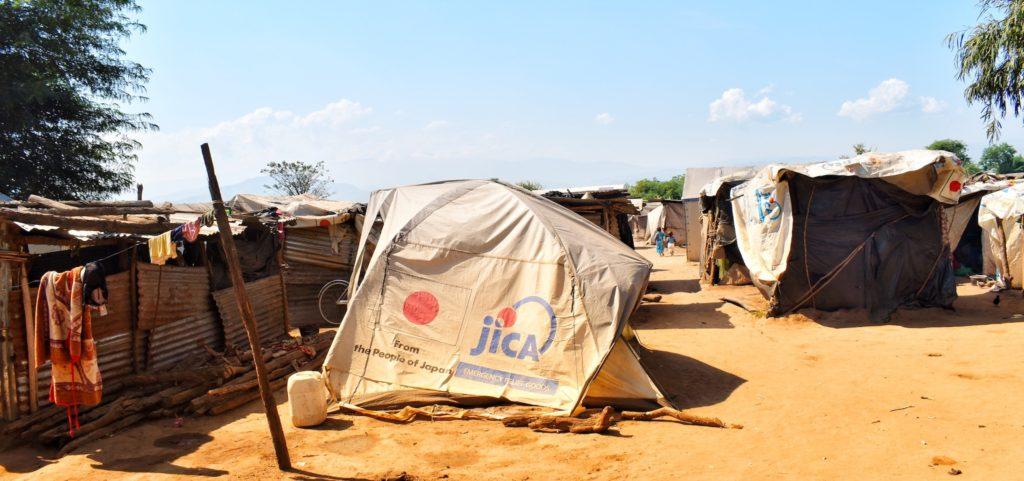CHIKWAWA (Malawi) The raging floods induced by Tropical Storm Ana devastated Malawi’s Chikwawa District, located on the west bank of the Shire River {about 50 kilometers south of Blantyre} and ripped Lameck Paulo’s home.
The 33-year-old father of three paused and shook his head while narrating the terrors of raging floods that fell on his Kanthema Village in Kasisi Traditional Authority in late January this year.
“It was on Monday the 24th. I brought home 13 cows and 41 goats. Together, they were to be sold the following day, but the floods took all,” recalls Paulo with a dejected face.
Paulo says that the sight of his cows, goats, and 30 chickens gasping for air as water swept them away still haunts him. “The livestock were my prized asset. I also lost two refrigerators, a plasma TV set, and a new motorcycle,” he laments.

The three-day torrents forced Matchombe River to break its banks with the ruthless surging waters submerging and crumbling homes in the area. “What mattered most was to save the lives of my children and wife,” says Paulo, standing on the rubble in his house.
Like other 259 displaced households in the area, he managed to escape with only the clothes he wore that night of the tragedy. The villagers fled to a congested Fombe Admarc evacuation Camp around 10 pm as the floods wrecked homes, livelihoods, and wealth.
The storm affected about one million people and displaced 190 000, and caused 46 deaths, according to the Department of Disaster Management Affairs (DODMA) in Malawi.
To address the survivors’ immediate needs, Malawi required about $71 million (Kwacha 72.7 billion), said the disaster department’s spokesperson Chipiliro Khamula. However, Khamula added the recovery and intervention needs are higher than the available resources.
Also listen to the COP27 President Special Representative Ambassador Wael Aboulmagd on why nations must prioritize action now and not backtrack on their climate action promises.
Silting rivers
Rivers in the Chikwawa district are shallow and buried in silt emanating from massively stripped highlands. Unyielding downpours culminate into devastating floods, shattering livelihoods, belongings, and lives.
Tropical Storm Ana also resulted in silted Mwanza River that burst its banks, displacing an entire Kanseche Village in Traditional Authority Lundu – about 13 kilometers from Kanthema Village.
The waters tumbled down over 500 houses and swept away belongings in the whole village, forcing all the 2380 Kanseche villagers to seek shelter at a cramped, unsanitary evacuation camp set in Dala village of traditional authority Maseya.
Elina Joseph, a 39-year-old woman subsistence farmer, now relying on well-wishers, says life has become tough after losing everything.
“I lost my house, food, crop field, all the money and inputs for my flitter cakes business and reduced to a beggar. It is hard to provide basic needs for my two girls,” says a teary Joseph inside her makeshift shelter at the camp.
Department of Climate Change and Meteorological Services (DCCMS) projects that due to climate change, Malawi will keep experiencing more extreme weather events, including intense tropical cyclones.
The DCCMS head of public weather services, Yobu Kachiwanda, says the country is vulnerable due to its proximity to the South West Indian Ocean where the cyclones develop and intensify.
“An average of nine tropical cyclones develop in this part of the ocean. Land degradation, poor settlement locations, and poor infrastructure development that does not accommodate climate information in the designing also increases the susceptibility of Malawi to cyclones.” explained Kachiwanda.

Teenage girls lost safety and dignity.
The UN sexual and reproductive health agency, United Nations Population Fund (UNFPA), reports that poor access to sanitary requirements during the natural biological process tramples women’s and girls’ rights to health, education, work, non-discrimination, and water and sanitation, among others.
For teen girls, the floods cost them safety and dignity as they face challenges managing their menses. Coupled with poverty, the girls cannot afford single-use sanitary pads sold in shops.
Chrissy Lindisoni says she had to use pieces of old clothes as floods washed away her sanitary kits.
For Joyce Mathews, myths around menses made it hard for her to participate in public life. “I was regarded as an outcast for failing to take care of myself—I had no pads, and I did not often bath due to lack of soap and water—during monthly periods. I was ashamed and in pain,” she says.
Scarcity of safe water, poor sanitation, and hygiene facilities such as soap and latrines aggravated girls’ mental torture and vulnerability to waterborne diseases. Pilirani Mailosi, the camp secretary, says overwhelmed by the single toilet most survivors defecated in the nearby bushes.
The UNFPA distributed dignity kits to adolescent girls and women to restore their menstrual health hygiene. At the same time, the Family Planning Association of Malawi intensified mobile clinics in the camps for survivors’ easy access to sexual reproductive health services and general medical care.

Little funds are available for recovery amid the crisis.
Malawi – a least developed country – is not only recovering from Tropical Storm Ana but also Tropical Cyclone Idai, which left nearly 90,000 people displaced and 60 dead in March 2019
Malawi’s total loss after Tropical Cyclone Idai was estimated at $220 million. But, a 2019 floods post-disaster needs assessment by the government of Malawi estimated the recovery and reconstruction would cost $370 million. However, after the 2019 floods, the disaster management department only received $80 million for recovery and reconstruction activities.
Forty-six ministers from Least Developed Countries (LDCs) meeting in Dakar, Senegal, this September warned the failure to act against climate change risks undermining decades of development.
In addition, the ministers meeting ahead of the 27th UN Climate summit (COP27) in El-Sheikh, Egypt, in November 2022 warns that the continued climate impacts will rob millions of developments.
Already, the African Development Bank warns that Africa will need as much as $1.6 trillion between 2020-2030 to implement its climate action commitments.
The LDC ministers call for new and additional loss and damage financing, a global goal on adaptation while calling on rich nations to raise their ambition in the fight against climate change and funding.
In the meantime, Joseph and other survivors keep sinking deeper into poverty with each climate-induced disaster.
“We have nowhere to go: our land is now a river. We are at the mercy of well-wishers and the government to support us with almost everything, including new places upland,” says Kanseche VCPC chairperson Mailosi. “All the survivors must start life again,” he concludes.
